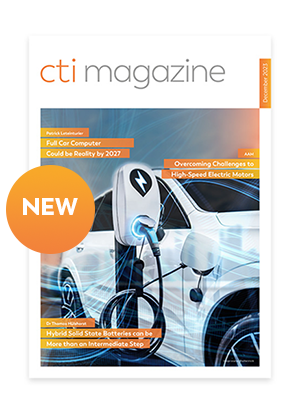
On their search for new ways to boost EV efficiency, designers keep coming back to thermal management. Optimizing coolant and refrigeration circuits for different components is proving to be a highly complex task – but one that offers decisive energy and cost saving opportunities.
Range, comfort, safety … ultimately, it all comes down to thermal management
Energy is a precious commodity in electric vehicles. Using sophisticated thermal management, designers can extend vehicle range at a stroke by reducing the power needed for optimal temp control of interiors and batteries. High-performance thermal management is also a must for fast charging – and the performance, operational reliability and service life of various system components all depend on a functional thermal management setup.
CTI Symposia cover the big picture in electrification. And all the details too.
Electromobility can make an important contribution to achieving global climate goals. That’s why the motto of the upcoming CTI Symposium USA is “Net-Zero Emissions”. At the event, top-notch experts will present their views in the plenary sessions and address leading-edge topics in panel discussions. At the same time, innovative technical solutions will be presented in eight technical sessions. Hot topics in the field of thermal management will include a thermal analysis tool for EDUs, a central coolant control module, and highly effective immersive cooling.
Detecting system-level thermal loads before they become hazardous
When checking EDU subsystems and components for smooth operation or dangerous hot spots, today’s designers have various tools at their disposal. But as Michael Furness (Drive System Design, USA) will explain in his talk, “With this kind of silo-based design approach, you risk overlooking crucial thermal interactions at system level.”
The Thermal Analysis Tool developed at Drive System Design accesses existing subsystem datasets to quickly generate a system-level thermal model of the design. The tool has been automated to ensure fast modeling. It can be used cost-effectively at every stage of the EDU development cycle, and can help to inform design decisions on every level. By running a system-level thermal analysis early on, designers can reduce the likelihood of costly changes further downstream. The short simulation cycle significantly reduces development time, and supports designers without the need to parameterize and apply costly FEA programs. Thanks to the tool’s modular implementation of heat transfer physics, designers can use simple empirical equations at an early design phase to obtain a rough understanding quickly. When more mature analyses become available, they can be fed into the tool to improve accuracy.
Using various case studies, Dr. Thomas Holdstock will demonstrate how the toolset can be used to optimize EDU cooling systems of differing complexity and performance, taking user-defined use cases and driving cycles into account.
Reducing complexity in the tangle of hoses, pumps and valves
In cold or hot weather, systems in battery-powered EVs expend a great deal of precious energy on heating and cooling, both of which reduce vehicle range. In response, carmakers are developing increasingly sophisticated thermal architectures. In turn, these increase the complexity of the valves, pumps, hoses and connections used in refrigerant and HVAC systems.
As Nicholas Jordan (HELLA, USA) will explain in his talk, the corresponding OEM trend involves centralizing thermal management system components as much as possible, and combining them in a single module. At HELLA, the most important innovation in this centralized approach is the way the supplier cooperates with OEMs when examining vehicle-specific architectures. To derive the best possible solution, three aspects are synchronized: the 1D vehicle architecture, system mode optimization, and the reduction of valve complexity. The coolant and refrigerant control modules developed by HELLA combine various combinations of cooling circuit elements for vehicle interiors, battery and e-motor/power electronics in a central module.
Since vehicle configurations depend on specific OEM architectures and assembly processes, HELLA offers customer-specific solutions. The goal of the advanced thermal management subsystem is always the same: to integrate cooling components in a single centralized module that can eliminate hoses and connections, and minimize assembly work.
Highly effective immersion cooling for electronic components
With tomorrow’s EVs aiming to charge fully in ten minutes or less, conventional cooling systems will likely reach their limits more and more frequently. Immersion cooling – in which electronic components make direct contact with a special dielectric liquid – is significantly more efficient.
In his talk, Tobias Bender (FUCHS Lubricants, USA) will present the latest generation of FUCHS thermal fluids. These fluids can take on central thermal management tasks in modern electric drives, and are specially designed for the direct immersion cooling of battery packs, traction motors and power electronics. The process has already been tried and tested successfully in data centers. The powerful, cost-effective and safe thermal management fluids enable robust and homogeneous cooling. Optimum operating temperatures can be maintained accurately, and thermal peak events avoided reliably. In the case of batteries, benefits include not only short charging times, but long service life and longer ranges too.
Tobias Bender will discuss the properties of the new thermal fluids in detail, drawing on various simulation and test methods and examining fluid properties, material compatibility, cooling efficiency and battery safety. The speaker will also compare the latest research results with those for established reference products, including non-hydrocarbon liquids. As the results show, direct immersion cooling using FUCHS dielectric liquid technology enables successive improvements compared to conventional liquid solutions.
CTI Symposium USA – we look forward to seeing you!
Our preparations for the CTI SYMPOSIUM in Novi (18 – 19 May 2022) are now shifting into top gear. A two-day program studded with highlights and prominent guests awaits you, and there’s still time to book your ticket. Be a part of it when experts and participants discuss tomorrow’s trends in the plenum and the eight technology sessions. Experience progress hands-on at the CTI SYMPOSIUM EXPO. Broaden your horizons in dialog with international experts – and make valuable new contacts in your field.
Welcome to CTI SYMPOSIUM USA!
